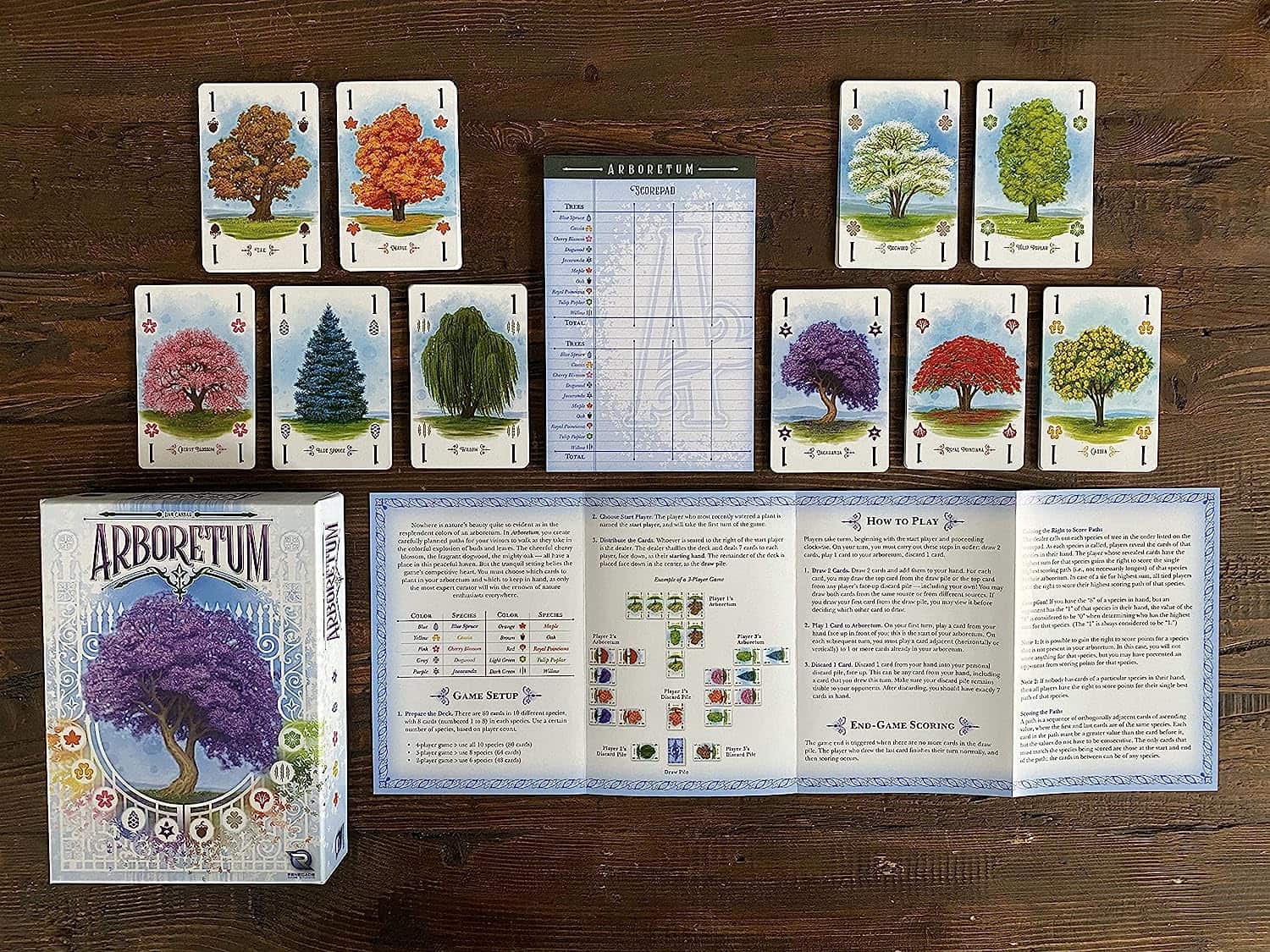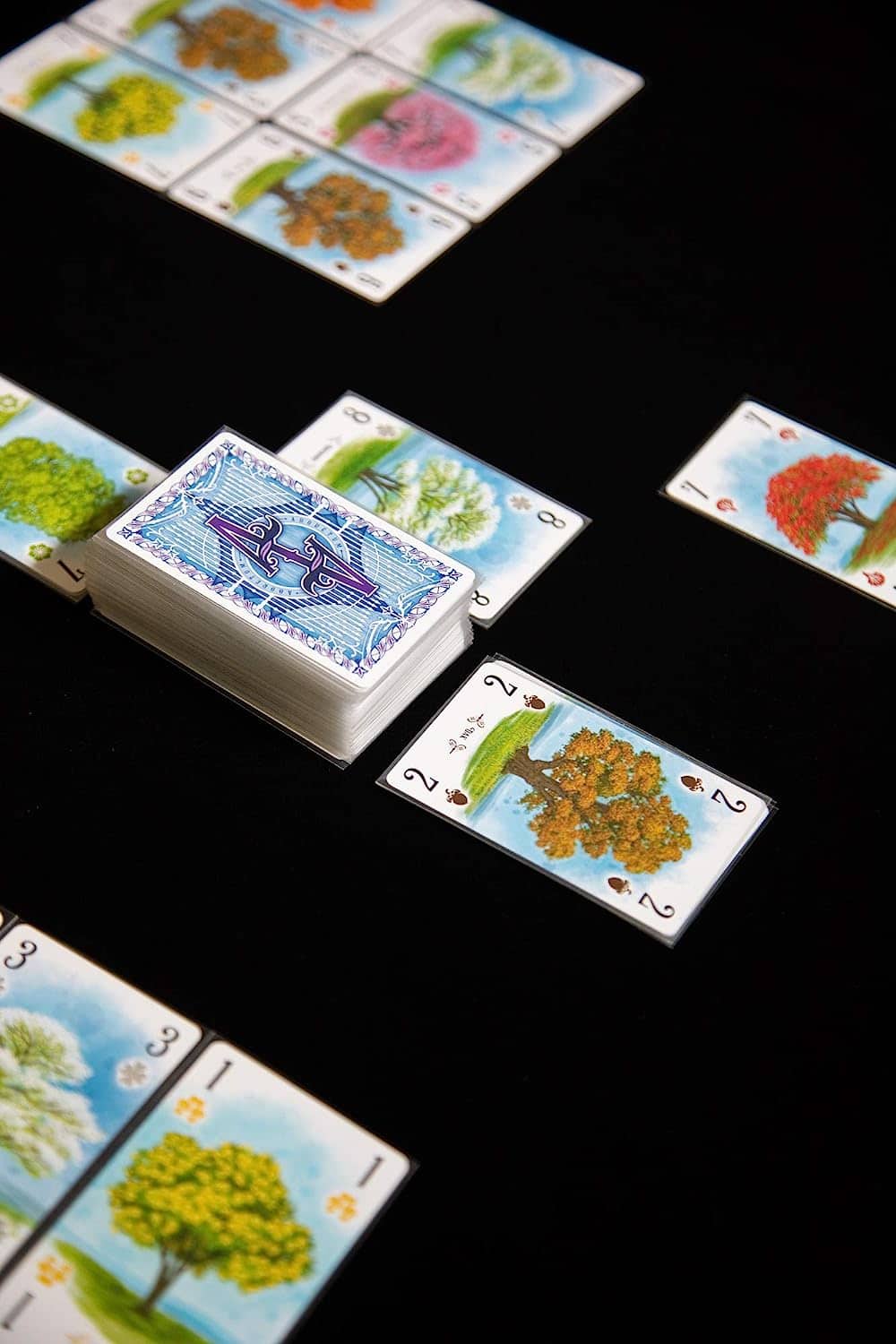Arboretum is not just a game; it’s a captivating journey through the world of lush, vibrant trees and captivating landscapes that will ignite your love for strategy and competition. In this delightful card game, players assume the roles of ambitious arborists, competing to create the most breathtaking and harmonious arboretums. Your task is to carefully plant, arrange, and cultivate a stunning collection of trees in your own private garden.
The catch? You must outmaneuver your opponents by tactically selecting and placing cards to maximize the beauty and diversity of your arboretum while disrupting their plans.
The game is a brilliant blend of horticultural aesthetics and fierce competition, where every turn is a thrilling puzzle to solve, and every move is an opportunity to showcase your creative genius. Whether you’re a seasoned strategist or a casual gamer, Arboretum promises endless fun and excitement, making it a must-play for anyone seeking a uniquely enjoyable and visually stunning gaming experience.
What’s included in Arboretum

- 80 Tree Cards: These cards represent different species of trees, each numbered from 1 to 8 in eight suits.
- 10 Scoring Cards: These cards indicate which species will score points at the end of the game.
- Instructions: The rulebook that guides you through setup and gameplay.
How to play Arboretum
Players compete to create the most beautiful and valuable arboretum (a garden of trees and shrubs) by arranging and connecting sets of tree cards. The goal of Arboretum is to create the most valuable paths of tree cards in your arboretum while strategically keeping valuable cards and hindering your opponents’ paths.
Setup
- Shuffle the 80 Tree Cards thoroughly and deal 7 cards to each player if playing with 2 to 4 players. In a 3-player game, deal 10 cards to each player. In a 4-player game, each player receives 7 cards.
- Place the remaining Tree Cards face-down in a draw pile.
- Shuffle the 10 Scoring Cards and draw one, placing it face-up in the center. The species indicated on this card will score points at the end of the game.
Rules for Arboretum

Arboretum is played over several rounds, each consisting of four phases: Draw, Play, Discard, and Draw.
- Draw Phase: At the beginning of your turn, you must draw two cards. You can either draw two cards from the draw pile or one card from the draw pile and one card from your opponent’s discard pile.
- Play Phase: During this phase, you must choose one card from your hand to play onto your own tableau. To do this, you must follow these rules:
- You can only play a card if it is adjacent to a card that shares either the same species or the same number.
- Cards of the same species (suit) must be played in ascending order (e.g., 2, 3, 4), and the numbers must be unique within the same species.
- Place the card face-up in your arboretum, extending or branching from an existing card in your tableau.
- If you discard a card from your hand during this phase, it goes to your personal discard pile.
- Discard Phase: You must discard one card from your hand face-up into your personal discard pile. You can choose any card from your hand to discard.
- Draw Phase (Again): Refill your hand to the required number of cards by drawing from the draw pile.
Scoring: At the end of the game, players score points based on the Scoring Cards in play. For each species (suit), the player with the highest total value of that species in their arboretum scores points. The player with the second-highest total also scores points, but lower than the first player. All other players receive no points for that species.
To score a species, you must have a continuous path of that species in your arboretum. A path is considered continuous if it starts with the lowest-numbered card of that species and ends with the highest-numbered card of that species.
Winning the Game: After scoring all species according to the Scoring Cards, the player with the most points wins. In case of a tie, the player with the longest continuous path in their arboretum wins.
Some optional rules/variants:
- Epic Game Variant: This variant involves using all 10 Scoring Cards instead of the usual one. This adds complexity and strategy to the game as players must compete for multiple types of trees and paths.
- Arboretum for Two Players: While Arboretum is primarily designed for 2-4 players, there are specific rules for two-player games to adjust the gameplay and balance.
- Solo Variant: Some players enjoy playing Arboretum as a solo experience. In this variant, you compete against your own performance, trying to maximize your own score according to the Scoring Cards.
- Alternate Scoring Cards: You can create your own set of Scoring Cards or use different sets to change the scoring dynamics of the game. This allows for a variety of strategic approaches and replayability.
- Variant for Easier Gameplay: If you find Arboretum too challenging or want a more relaxed experience, you can use a variant where you don’t need a continuous path for scoring. This simplifies the game but still retains its core mechanics.
- Team Play: In this variant, players can form teams and work together to create the best arboretum. You can adjust the rules and scoring to accommodate team play.
- Timer Variant: Introducing a timer to each player’s turn can add a sense of urgency to the game, making decisions more challenging under time pressure.
- Advanced Tree Card Abilities: Some players like to introduce special abilities for certain tree cards to add extra layers of strategy and complexity.
For the official rules, see the link below:
How to win in Arboretum
- Plan Your Paths Carefully: The heart of Arboretum is creating continuous paths of trees to score points. Plan ahead and consider which species (suits) you want to focus on, and try to build uninterrupted paths of those species. Remember, you can only score a species if you have the highest total value of that species, so prioritize accordingly.
- Secure Key Species: Early in the game, identify and secure important species. For example, if the Scoring Card for the willow (number 5) is in play, prioritize getting a strong willow path. You can also try to collect cards that block your opponent’s paths in the same species.
- Card Management: Pay close attention to your hand and the cards in your discard pile. Keep cards in your hand that can extend your paths or disrupt your opponent’s plans. Utilize the discard pile to deny your opponent valuable cards when they draw from it.
- Observe Your Opponent: Keep an eye on your opponent’s arboretum and try to anticipate their strategy. If you notice they are heavily investing in a specific species, consider blocking or competing for it.
- Scoring Card Awareness: Always be aware of the current Scoring Card and how it affects your strategy. Prioritize paths that align with the active Scoring Card, especially if you can secure the highest total value in that species.
- Balance Resource Cards: While it’s essential to focus on specific species, don’t neglect the resource cards (numbered 1-8) as they are versatile and can help you extend multiple paths. Balance your hand between species and resources to maintain flexibility.
- Draw Wisely: Choose your draw options carefully. Drawing from the deck can give you access to fresh cards, but drawing from your opponent’s discard pile can deny them valuable cards. Evaluate the trade-off in each situation.
- Evaluate Risk: Consider the risks associated with discarding specific cards. Discarding a card may give your opponent access to it, potentially enabling them to complete a path or block you.
- Long Paths: Attempt to create long, uninterrupted paths of valuable species. Longer paths are more likely to secure the highest total value and gain more points.
- Adapt to Scoring Changes: Be prepared to adjust your strategy if a new Scoring Card is revealed. You may need to pivot and focus on different species based on the changing scoring criteria.
- Endgame Focus: In the final rounds, prioritize extending your highest-scoring paths and denying your opponent’s scoring opportunities. The endgame can often make or break your chances of winning.
- Practice and Experience: As with any game, practice and experience will improve your strategic skills. Familiarize yourself with the card combinations and develop a sense of which species are likely to be in play.